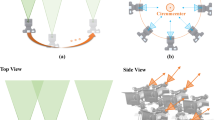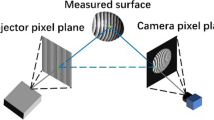Abstract
Lens effects are crucial visual elements in the synthetic imagery, but rendering lens effects with complex full lens models is time-consuming. This paper proposes a polynomial regression-based approach for constructing a sparse and accurate polynomial lens model. Terms of a polynomial are built adaptively in a bottom-up approach. Depending on the distribution of aberrations, this approach partitions the light field and builds separate polynomial models for local light fields. A line pupil-based sampling method is presented to accelerate the generation of camera rays. In addition, a new Monte Carlo estimator is derived to support general Monte Carlo rendering. Experiments show that this approach significantly reduces the time cost of constructing a polynomial lens model in comparison to state-of-the-art methods, while achieving high imaging accuracy.












Similar content being viewed by others
References
Hullin, M.B., Hanika, J., Heidrich, W.: Polynomial optics: a construction kit for efficient ray-tracing of lens systems. Comput. Graph. Forum 31(4), 1375–1383 (2012)
Hanika, J., Dachsbacher, C.: Efficient Monte Carlo rendering with realistic lenses. Comput. Graph. Forum 33(2), 323–332 (2014)
Schrade, E., Hanika, J., Dachsbacher, C.: Sparse high-degree polynomials for wide-angle lenses. Comput. Graph. Forum 35(4), 89–97 (2016)
Potmesil, M., Chakravarty, I.: A lens and aperture camera model for synthetic image generation. ACM SIGGRAPH Comput. Graph. 15(3), 297–305 (1981)
Kolb, C., Mitchell, D., Hanrahan, P.: A realistic camera model for computer graphics. In: Proceedings of SIGGRAPH ’95. SIGGRAPH ’95. ACM, New York, pp. 317–324 (1995)
Gauss, C.F.: Dioptrische untersuchungen. Dioptrische Untersuchungen, by Gauss, Carl Friedrich 1 (1841)
Heidrich, W., Slusallek, P., Seidel, H.P.: An image-based model for realistic lens systems in interactive computer graphics. Graphics Interface ’97, pp 68–75 (1997)
Lee, S., Eisemann, E., Seidel, H.P.: Real-time lens blur effects and focus control. ACM Trans. Graph 29(4), 65:1–65:7 (2010)
Hullin, M., Eisemann, E., Seidel, H.P., Lee, S.: Physically-based real-time lens flare rendering. ACM Trans. Graph 30(4), 108:1–108:10 (2011)
Steinert, B., Dammertz, H., Hanika, J., Lensch, H.P.: General spectral camera lens simulation. Comput. Graph. Forum 30(6), 1643–1654 (2011)
Wu, J., Zheng, C., Hu, X., Xu, F.: Rendering realistic spectral bokeh due to lens stops and aberrations. Vis. Comput. 29(1), 41–52 (2013)
Zheng, N., Hagen, N., Brady, D.J.: Analytic-domain lens design with proximate ray tracing. JOSA A 27(8), 1791–1802 (2010)
Hopkins, G.W.: Proximate ray tracing and optical aberration coefficients. JOSA 66(5), 405–410 (1976)
Lee, S., Eisemann, E.: Practical real-time lens-flare rendering. Comput. Graph. Forum 32(4), 1–6 (2013)
Tropp, J.A., Gilbert, A.C.: Signal recovery from random measurements via orthogonal matching pursuit. IEEE Trans. Inf. Theory 53(12), 4655–4666 (2007)
Pudil, P., Novovičová, J., Kittler, J.: Floating search methods in feature selection. Pattern Recognit. Lett. 15(11), 1119–1125 (1994)
Todorovski, L., Ljubič, P., Džeroski, S.: Inducing polynomial equations for regression. In: European Conference on Machine Learning. Springer, Berlin, pp. 441–452 (2004)
Jekabsons, G., Lavendels, J.: Polynomial regression modelling using adaptive construction of basis functions. In: Proceedings of IADIS International Conference, Applied Computing, pp. 269–276 (2008)
Smith, W.J.: Modern Lens Design, 2nd edn. McGraw-Hill New York, Maidenhead (2005)
Guyon, I., Elisseeff, A.: An introduction to variable and feature selection. J. Mach. Learn. Res. 3, 1157–1182 (2003)
Pharr, M., Jakob, W., Humphreys, G.: Physically Based Rendering: From Theory to Implementation, 3rd edn. Morgan Kaufmann, Burlington (2016)
Jakob, W., Marschner, S.: Manifold exploration: a Markov chain Monte Carlo technique for rendering scenes with difficult specular transport. ACM Trans. Graph. 31(4), 58:1–58:13 (2012)
Kelemen, C., Szirmay-Kalos, L., Antal, G., Csonka, F.: A simple and robust mutation strategy for the metropolis light transport algorithm. Comput. Graph. Forum 21(3), 531–540 (2002)
Lafortune, E.P., Willems, Y.D.: Bi-directional path tracing. In: Proceedings of Third International Conference on Computational Graphics and Visualization Techniques (Compugraphics ’93), pp. 145–153 (1993)
Hachisuka, T., Jensen, H.W.: Stochastic progressive photon mapping. ACM Trans. Graph. 28(5), 14:11–14:18 (2009)
Acknowledgements
This work was supported in part by the research grant (ref. 9140A21010115HT05003). The camera lens data are courtesy of Emanuel Schrade et al.
Author information
Authors and Affiliations
Corresponding author
Electronic supplementary material
Below is the link to the electronic supplementary material.
Rights and permissions
About this article
Cite this article
Zheng, Q., Zheng, C. Adaptive sparse polynomial regression for camera lens simulation. Vis Comput 33, 715–724 (2017). https://doi.org/10.1007/s00371-017-1402-9
Published:
Issue Date:
DOI: https://doi.org/10.1007/s00371-017-1402-9




